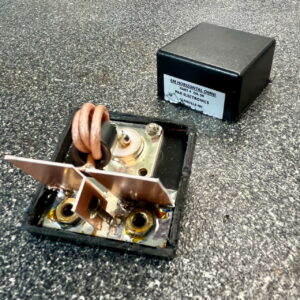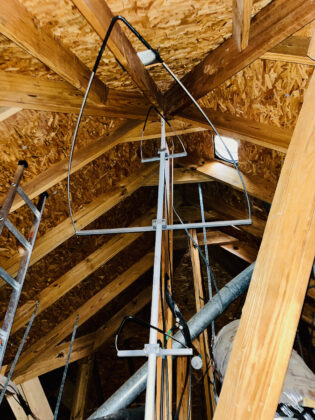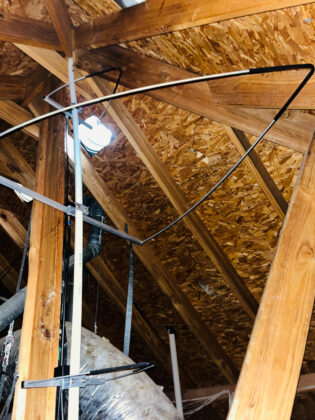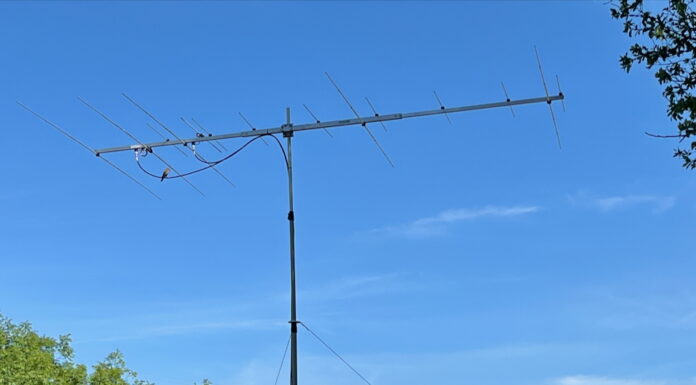Then I started using their omniangles for 50, 144, 222, and 432 MHz. They use the same type of construction as the Moxon. Plus, they have outstanding omnidirectional characteristics. Please read all about it at Par Electronics Omniangles. If you want more background, please dive deeper into the testing report and the Omni FAQ page.
You can see the size of the six-meter Omniangle in the photo above, where I’m holding it sideways so you can get a better idea of its size.
For this round of the antenna workshop, I decided to mount two of the two-meter omniangles in a stacked arrangement. This is expected to provide a 3 dB gain over the single omni. I’m planning to use this for local rag chewing and nets. It will also prove helpful during contests in picking up local QSOs without pointing the antenna.
Nearby, I’ve posted a couple of photos of the setup. I used a PVC pipe hanging from the roof inside the attic. It’s a two-story house. So the height is pretty good. The required stacking distance is anything between 4 and 5 feet. I’ve used 4.5 feet.
In between the two-meter antennas, I’ve mounted the single six-meter omni. The cables are routed through the attic and down into the ham shack. In the photos, you can see the HVAC ductwork and chimney. I’m sure that doesn’t help the radiation pattern. But it’s what I’ve got!
I’m looking forward to trying out this setup for local QSOs and in the June VHF Contest.
 Update June 2025 – There are power limitations on these antennas. For the 6-meter antenna, the power limit is 200 watts. For the 2-meter antenna, it’s 250 watts. I know this because I popped the 6-meter version. Dale forwarded a new balun/interface unit. I replaced it and it now works fine again. Plus, I’m more cautious about switching to the 6-meter Omniangle. For the 2-meter version, my maximum output is 300 watts, which is split across the two stacked antennas. So I should be good there.
Update June 2025 – There are power limitations on these antennas. For the 6-meter antenna, the power limit is 200 watts. For the 2-meter antenna, it’s 250 watts. I know this because I popped the 6-meter version. Dale forwarded a new balun/interface unit. I replaced it and it now works fine again. Plus, I’m more cautious about switching to the 6-meter Omniangle. For the 2-meter version, my maximum output is 300 watts, which is split across the two stacked antennas. So I should be good there.
Always curious, I cut open the blown balun/interface unit. You can see the nearby photos of how ingenious it’s constructed with PC board capacitors and a ferrite balun—pretty cool stuff.











[…] Omniangle omnidirectional antennas Stacked for more fun. K5ND […]
[…] helped me on two meters was using the stacked Par Electronics omniangles. I could listen and send a few CQs without moving the antenna. That helped me snag a few QSOs and […]
Hi Jim! Just curious if you had a way, in your personal experience, to quantify the difference in the single and the double. I just purchased (2) and a harness. Thinking about putting them on the tower.
Thanks!
Mike
W5UC
Hi Mike, Of course, the quantified difference between single and double is +3 dB. From my personal experience, the double works well. Since I have to turn my Yagis by running down the stairs and out to the backyard to armstrong them, turning a switch in the shack to the stacked Omnis can prove very helpful. That’s particularly true during a contest when multiple stations are on the air. Plus, when activity is low, it can be helpful, or at least comforting, to call CQ on the stacked omnis, hoping someone will respond. Good luck with your installation. I hope to work you in the future. 73, Jim, K5ND
Thanks Jim! I’ve got my Yagi down currently for maintenance. Once I get it back up, I’d love to work you. I’m SE of you about 70 miles. Usually around 144.200, 144.210 or often in evenings at 144.240. Hope we can work.
Thanks again!
God bless & 73,
Mike
W5UC
Sounds good.